Females rely on immediate dietary intake, as opposed to storage in the hepatopancreas, as a source for nutrients for ovarian development
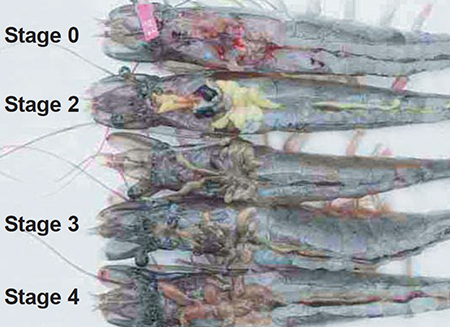
Nutrition has been identified as a crucial factor for the maturation and reproduction of captive penaeid shrimp and crustaceans in general. Moreover, maternal shrimp nutrition also affects the quality of the offspring, especially since shrimp nauplii do not feed but rely on egg yolk during development to the zoea stage.
In a study, the authors examined the role of lipids and vitamins in the penaeid reproduction process. Wild (Litopenaeus vannamei) females in different stages of sexual maturation (including spent females) were sampled, as were their nauplii to determine lipid content, lipid class composition, fatty acid composition, and content of vitamins C and E.
Lipids
Dietary lipids are required in relatively high concentrations as an energy source either for growth or reproduction. It is generally thought that the lipid requirements of shrimp broodstock are higher than those of juveniles.
Ovarian lipids
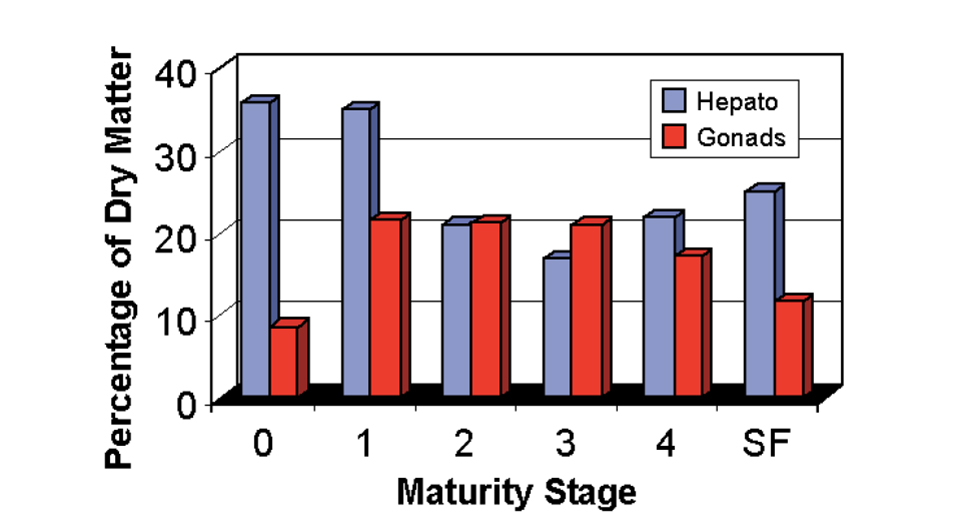
Analysis of ovarian tissue seemed to confirm the importance of dietary lipids (Fig. 1). A significant increase in percent lipids was observed in shrimp from immaturity at stage 0 to early maturing at stage 1. This evolution has also been observed in other shrimp species and crustaceans in general, although lipid accumulation continues in other species until ovarian maturation is complete.
Relative contributions unclear
What remains unclear in most studies is the relative contribution of reallocation of lipid stores from other tissues, de novo synthesis, and recent dietary intake. We observed a decrease in hepatopancreas total lipids from stage 1 to stage 2 (mid-maturing). This was after the lipid accumulation in the ovaries reached its maximum, suggesting that a substantial part of the lipids that accumulated in the ovaries originated from the diet and not the hepatopancreas.
Commercial broodstock diets
In current commercial artificial broodstock diets, total lipids are indeed formulated at levels of approximately 10 percent or higher, which is 3-5 percent more than in grow-out diets.
Highly unsaturated fatty acids
Highly unsaturated fatty acids (HUFA) are generally believed to be required in high levels in broodstock diets. Our study demonstrated that hepatopancreas, gonads, and nauplii of wild L. vannamei contained high HUFA levels, indicating the importance of HUFA to sustain normal reproductive output and offspring quality.
Interestingly, a decrease in the levels of arachidonic acid and eicosapentaenoic acid was observed in the ovaries during early maturation (Table 1), while other HUFAremained stable. Apparently, HUFA from recently ingested feed were not accumulated in the ovaries during maturation, indicating that ovarian HUFA levels did not need to be high for the process of ovarian development to proceed normally.
Wouters, Fatty acid composition (in % of total FA) in gonads of Litopenaeus vannamei, Table 1
| Maturity Stage 0 | Maturity Stage 4 | Maturity Stage SF | Nauplii |
|---|
Maturity Stage 0 | Maturity Stage 4 | Maturity Stage SF | Nauplii | |
|---|---|---|---|---|
| Arachidonic Acid | 8.7c | 4.8ab | 5.3b | 4.3 |
| Eicosapentaeonic Acid | 15.0b | 10.4ab | 14.1ab | 13.8 |
| Docosahexaenoic Acid | 9.8a | 7.7a | 9.0a | 8.4 |
Table 1. Fatty acid composition (in % of total FA) in gonads of Litopenaeus vannamei in different stages of sexual maturation and in nauplii. Mean values.
However, based upon the literature and results obtained in other studies by our group, it can be stated that HUFA play an important role in several other aspects of the reproductive process (e.g., egg fertilization and fecundity) and larval development. For these, dietary HUFA levels of 2 percent are recommended for L. vannamei broodstock diets.
Vitamin C
As shown in Fig. 2, levels for vitamin C (ascorbic acid) were high in immature, maturing, and mature ovaries. Levels were much lower in the ovaries of spent females and nauplii. If ovarian vitamin C was transferred to the eggs before spawning, the low naupliar levels suggested the vitamin was consumed during embryology and therefore played a role in egg development and hatching. However, broodstock females may have used vitamin C during stress periods such as the spawning process.
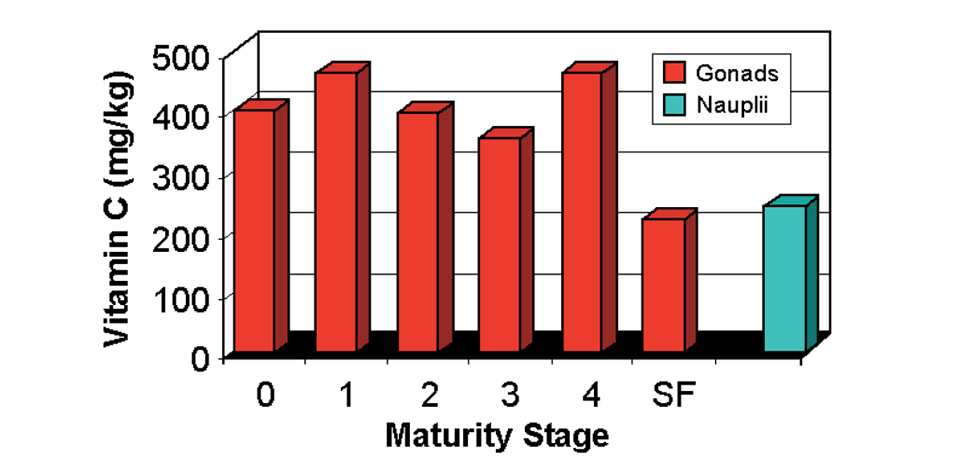
Vitamin E
Vitamin E (α-tocopherol) levels were low in immature ovaries, increased substantially during ovarian maturation, and then decreased again upon spawning (Fig. 3). High vitamin E levels were retained in the nauplii.
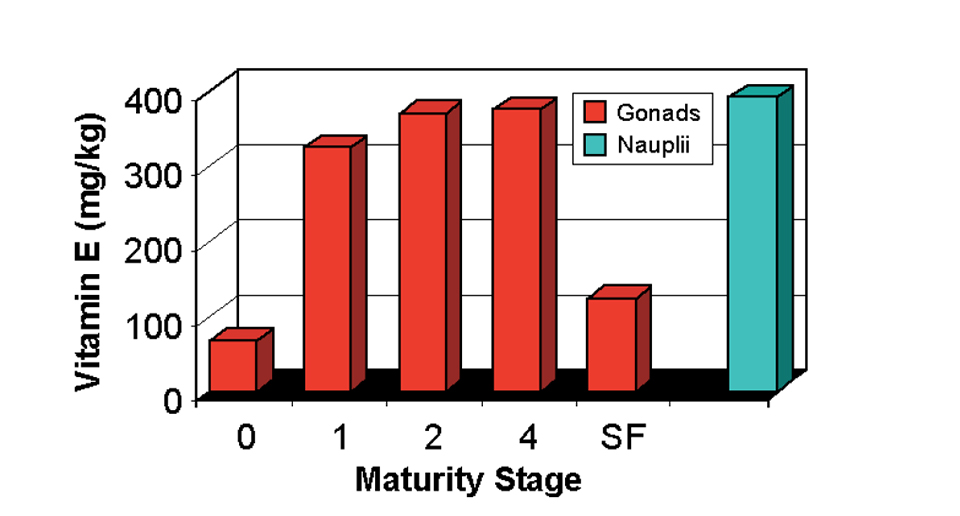
The accumulation of vitamin E in the ovaries suggested the importance of this vitamin for the process of ovarian maturation. It is known that shrimp broodstock can interrupt the maturation process and return to an immature stage by nutrient reabsorption and oocyte atresia if dietary nutrient levels or body reserves are insufficient to allow accumulation in the ovaries above threshold levels.
The effective transfer of vitamin E to the eggs and conservation of high levels in the nauplii further indicated that vitamin E played an important role during larval development as a constituent of the cell membrane.
Antioxidant properties
One function of vitamins C and E in solution, membranes, and lipoproteins is related to their respective hydrophilic and lipophilic antioxidant properties in protecting cell constituents such as HUFA by scavenging radicals. Furthermore, vitamin C reduces the resulting α-tocopherol radical efficiently to regenerate a-tocopherol. This relationship may be an additional reason why vitamin C levels are low and vitamin E levels are high in nauplii.
Conclusion
The biochemical characterization of wild female broodstock provides baseline data and increases our knowledge on the roles of specific nutrients in shrimp maturation. Based on this information, females rely primarily on immediate dietary intake, as opposed to storage in the hepatopancreas, as a source for nutrients for ovarian development.
HUFA levels of ovaries declined during maturation, suggesting 2 percent HUFA would be adequate for broodstock diets. However, levels of vitamins C (461 milligrams per kilogram) and E (377 milligrams per kilograms) were elevated, suggesting greater dietary requirement.
(Editor’s Note: This article was originally published in the December 2001 print edition of the Global Aquaculture Advocate.)
Now that you've reached the end of the article ...
… please consider supporting GSA’s mission to advance responsible seafood practices through education, advocacy and third-party assurances. The Advocate aims to document the evolution of responsible seafood practices and share the expansive knowledge of our vast network of contributors.
By becoming a Global Seafood Alliance member, you’re ensuring that all of the pre-competitive work we do through member benefits, resources and events can continue. Individual membership costs just $50 a year.
Not a GSA member? Join us.
Authors
-
-
César Molina
Jorge Calderón, Ph.D.
CENAIM-ESPOL Foundation Guayaquil, Ecuador
Tagged With
Related Posts
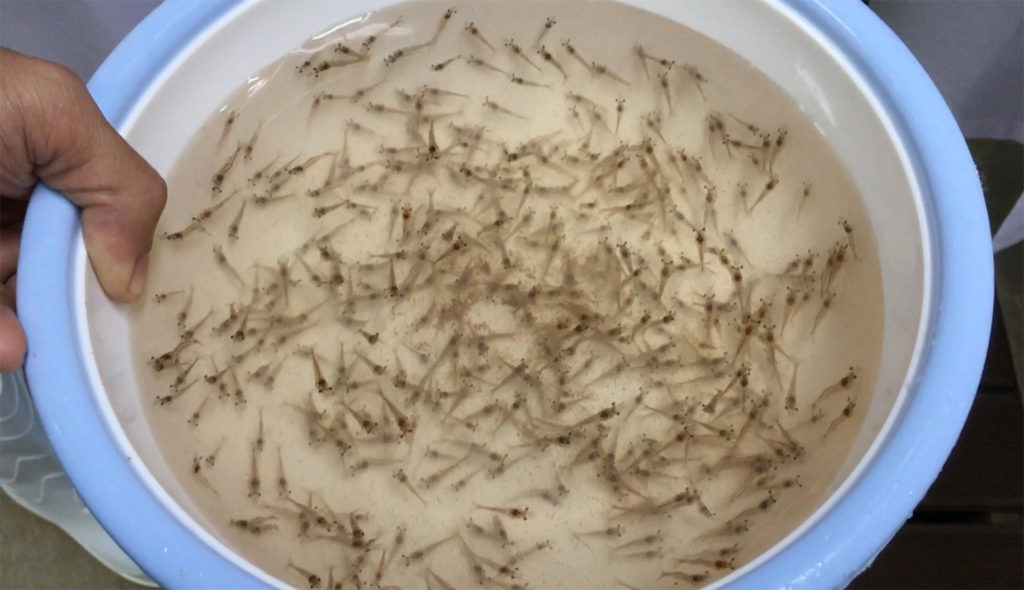
Health & Welfare
Challenging Pacific white postlarvae with AHPND
Study results indicate that P. vannamei challenged with AHPND in biofloc had higher survival rates than shrimp challenged in clear water.
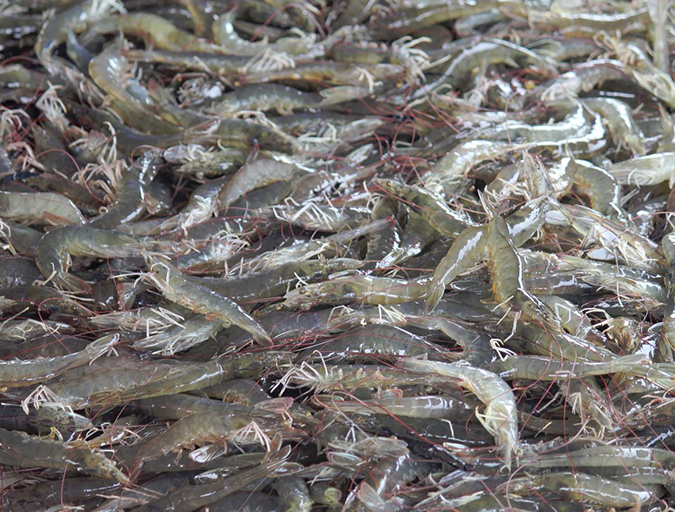
Health & Welfare
Four AHPND strains identified on Latin American shrimp farms
Two virulence genes are known to encode a binary photorhabdus insect-related toxin that causes acute hepatopancreatic necrosis disease in shrimp. The pathogenicities of these V. campbellii strains were evaluated through laboratory infection and subsequent histological examination in P. vannamei shrimp.
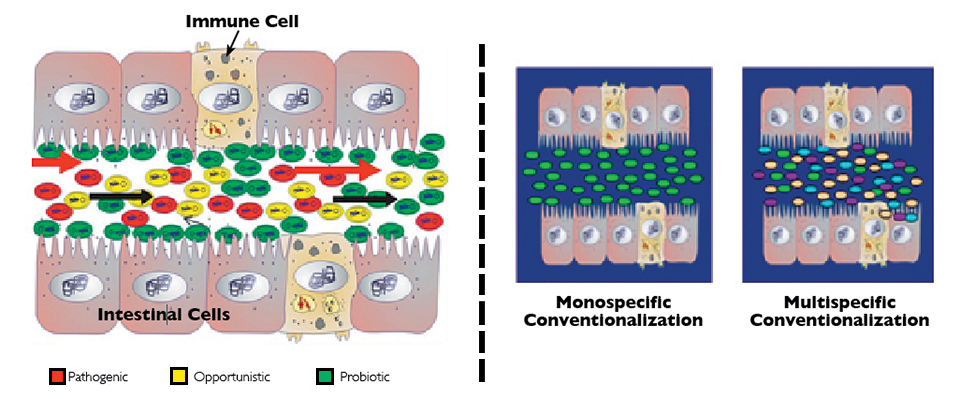
Health & Welfare
Domestication of gut microbiota can improve shrimp aquaculture
In studies, bacteria and yeasts isolated from the native microbiota of wild shrimp at larval, juvenile and adult life stages were administered to early-stage shrimp via the culture water.

Health & Welfare
Postlarvae evaluation key to controlling shrimp diseases
Establishing postlarvae quality has become one of the most important aspects in controlling diseases in farmed shrimp. Initial microbial testing can ensure viruses and other pathogens are absent from the animals.


